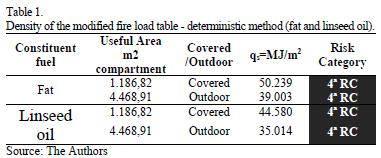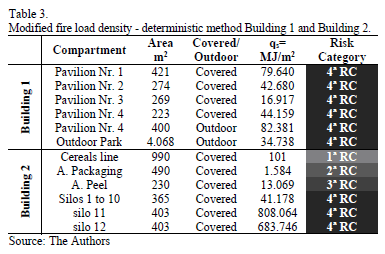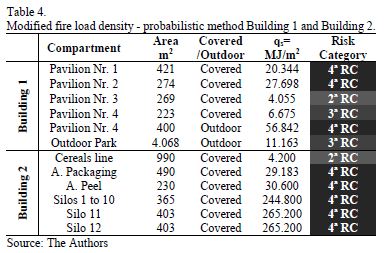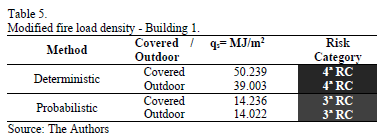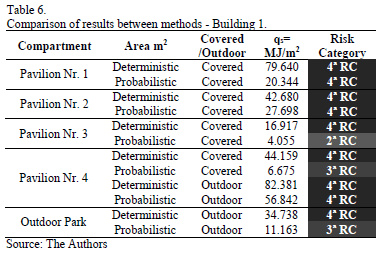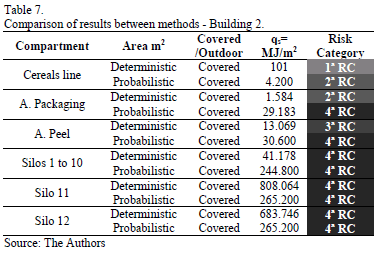Serviços Personalizados
Journal
Artigo
Indicadores
-
 Citado por SciELO
Citado por SciELO -
 Acessos
Acessos
Links relacionados
-
 Citado por Google
Citado por Google -
 Similares em
SciELO
Similares em
SciELO -
 Similares em Google
Similares em Google
Compartilhar
DYNA
versão impressa ISSN 0012-7353
Dyna rev.fac.nac.minas vol.83 no.196 Medellín mar./abr. 2016
https://doi.org/10.15446/dyna.v83n196.56602
DOI: http://dx.doi.org/10.15446/dyna.v83n196.56602
Variation in risk category in methods of calculation of the modified fire load density
Variación de la categoría de riesgo en los métodos de cálculo de la densidad de carga de fuego ponderada
Cristina Maria Paulo Cadete-Pires a, Rui António de Carvalho-Veiga b & Maria Isabel Simões-Miguel c
a Graduate in Occupational Safety Engineering- ISLA, Santarém - Portugal. cadete.pires@gmail.com
b Specialist Teacher in Safety and Health at work - ISLA, Santarém - Portugal. rveiga.sht@gmail.com
c Assistant professor of Human Resources Management - ISLA Santarém - Portugal. isabel.miguel@unisla.pt
Received: December 7th, 2015. Received in revised form: February 20th, 2016. Accepted: March 07th, 2016.
This work is licensed under a Creative Commons Attribution-NonCommercial-NoDerivatives 4.0 International License.

Abstract
The management of fire safety in buildings is conducted in accordance with the type of use-risk category (Building occupancy code). For Building type XI "libraries and archives" and XII "industrial, workshops and warehouses", the determination of the risk category involves the calculation of the modified fire load density, which can be done by two methods used interchangeably by the technician: deterministic and probabilistic. This study aims to investigate variation results obtained with the calculation of the modified fire load density using two methods and the classification of the Building occupancy code. The performed calculations referred to real buildings of type XII, with defined and distinct materials and activities. The different results determine a variation in the risk category, which consequently, will define the technical criteria to be applied to the Building occupancy code in the implementation for Building Fire Safety measures.
Keywords: Fire Safety in Buildings; fire load; deterministic; probabilistic.
Resumen
La gestión de seguridad contra incendios en los edificios se efectúa de acuerdo a la categoría de riesgo dependiendo del tipo de utilización (TU). Para el TU XI «bibliotecas y archivos» y XII «industrias, talleres y almacenes», la determinación de la categoría de riesgo implica el cálculo de la densidad de la carga modificada del incendio, que puede ser efectuada mediante dos métodos, utilizados de forma indistinta por el técnico: determinístico y probabilístico. Este estudio, tiene como objetivo investigar la variación de los resultados obtenidos del cálculo de la densidad de la carga modificada del incendio por dos métodos y la clasificación TU. Los cálculos efectuados hacen referencia a dos TU XII reales con distintos materiales y actividades definidas. La diferencia de los resultados obtenidos por los métodos determina la variación de la categoría de riesgo, que consecuentemente, va a definir cuáles son los criterios técnicos a aplicar sobre la TU en la implementación de medidas de SCIE.
Palabras clave: Riesgo de incendio, densidad de carga de fuego.
1. Introduction
The main objective of fire safety regulations developed and implemented in most countries is the protection of workers and the reduction of losses in organizations [10].
Buildings' fire safety, in Portugal, walks hand in hand it with the technical and technological changes that accompany the construction process of buildings making it possible to evolve and adapt during construction. Increasingly, the concern with fire safety is left is not only to protect but nowadays, and increasingly, also to prevent [8].
With the implementation of the current legal regime for Fire Safety in Buildings, any project or self-protection measure necessarily implies the classification of buildings according to their uses (Building occupancy code). The determination of the classification of risk categories applicable to Building type XI "libraries and archives" and XII "industrial, workshops and warehouses" implies the calculation of the modified fire load density [1]. The Legal Portuguese Regime of Fire Safety in Buildings refers to the concept of fire load and modified fire load density for measuring those calculations [2].
The fire load corresponds to the probable volume of heat to be released by the complete combustion of all elements in a space, including the lining of walls, partitions, floors and ceilings. The modified fire load density is the fire load density affected by coefficients referred to the degree of danger and the fuel activation rate as mentioned in article 2 of Decree-Law 220/2008 of 12th November-Portugal [2].
The technical criteria for determining the modified fire load density is defined in the legal technical regulation Nr. 2074/2009, of 15th January-Portugal [3]. This Law Decree, points out two calculation methods that can be used interchangeably. The deterministic method, based on prior knowledge of the quantity and quality of existing materials in the studied section, and the probabilistic method based on statistical results of the type of activity in the studied section [3].
The calculations were made using any of the methods for determination of the modified fire load density of a site or group of sites belonging to the same fire compartment, i.e. the part of a building, comprising one or more spaces, rooms or floors enclosed by the building elements with suitable resistance to fire for a certain period of time to ensure the protection of the building or to prevent the spread of fire to the rest of the building, or even the fire load to fractionate [4].
Although the calculations are simple, it is important to have adequate knowledge to be able to apply the presented formulas and obtain real consistent values. The complexity of the legislation requires that only skilled technicians can prepare projects and measures of self-protection [5].
1.1. Objectives
To conduct studies in the field of fire safety in buildings based on the results of the calculation of the fire load density modified by two different methods and the risk category classification. The following precise objectives were established:
1st - Determine if it is indifferent to method selection of calculation of the modified fire load density to classify risk category of Buildings type XI and XII;
2nd - Analyse if a definition of criteria is required when a method is selected in order to standardize procedures in the implementation of the measures of Portuguese Fire Safety in Buildings.
2. Materials and methods
In the study, two real Building types are described with defined materials and activities, modified fire load density is calculated using two methods and the Buildings are classified in risk category based on the obtained results.
The facilities of the first Building have no fireguard, despite being divided into pavilions, it is considered in terms of foreclosure as a single building, and the calculations were made for the covered space and outdoors. Later, the same calculations were made considering the subdivided building with fireguard.
The second Building has fireguard and all areas are covered.
The modified fire load density (qs) corresponds to the heat energy that can be released in case of fire, presented in megajoules per square meter (MJ/m2) and can be determined from the presented formulas in the legal technical regulation Nr. 2074/2009 15th January-Portugal [3,7]And also referred to the NTP 766 - Technical Notes of Prevention [9]: Deterministic calculation eq. (1)

Where:
= Mass in kg, of fuel constituent (i);
= Lower heating value in
, of fuel constituent (i);
= Dimensionless coefficient of combustibility of fuel constituent (i);
= Dimensionless coefficient of activation of fuel constituent (i);
S = Useful area of fireguard compartment in m2.
Probabilistic calculation: manufacturing eq.(2), storage eq.(3) and total Building eq (4)

Where:
= Fire load density for the type of activity (i) em
;
= Activity zone area (i) in
;
= Dimensionless coefficient fuel constituent of combustibility with higher risk of combustibility present in the activity zone (i);
= Number of distinct activities areas.

Considering the parameters of the previous equation (1 and 2) except for the following:
= Fire load density per unit volume on the storage area (i) in
;
= Storage height of the storage area (i) in
;
= Number of distinct storage areas.

Where:
= Modified fire load Density, in
, each compartment fireguard (k);
= Useful area of each compartment fireguard (k) in
;
= Number of fireguard sections.
In the legal technical regulation Nr. 2074/2009 of 15th January-Portugal [3] are the specifications for featured formulas and in its annex are published tables with the coefficients needed for the calculations.
2.1. Deterministic method
It requires knowledge of the quantity and quality of materials, so an inventory was made of all products and their respective quantities (kg) of the studied Buildings.
2.2. Probabilistic method
This is based on statistical results for the type of activity in the mentioned fireguard compartments.
2.2. Classification of Risk Category
After the calculation of the modified fire load in the Building under study it was determined as a type XII risk category according to the X framework of Annex III of Decree Nr. 220/2008 of 12th November-Portugal [2].
3. Study Case
This study was based in two type XII Buildings with distinct activities, manufacture and storage and they were designated as Building 1 and Building 2.
Building 1 has storage and does refining of oils, and all products are manufactured and stored in tanks with the maximum capacity of 80% tank volume.
The stored products and subjected to refining are mainly made from cooking oil. Referring to Table 1 of the legal Technical Regulation Nr. 2074 / 2009 January 15th [3] it is stated that in order to calculate the calorific fuel power (Hi), the material that has similar characteristics may be Flaxseed Oil (Hi = 37.2 MJ/kg) and fat (Hi = 42MJ/kg). In order to demonstrate if this choice influenced the value of the modified fire load, calculations were made using the two values.
Building 2 is dedicated to drying, storage and processing of grain. All products are stored in silos, verifying the maximum capacity of 100%.
4. Results
In the first phase of the study it was verified that calculation results of Building 1 differed significantly, if they were based on constituent fuel fat or linseed oil. The calculations performed by the deterministic method revealed the results represented in Table 1.
Once verified that there is no significant difference in the results, the remaining calculations were made with fat component.
First, and because, according to the organization, this is what corresponds to the stored and manufactured products and secondly because it has higher Hi, thus being the most prudent calculation [6].
In the second phase we calculated the density of the modified fire load by the probabilistic method (Table 2).
In the third phase, we proceeded equally, the calculation of the fire load density per shed by deterministic and probabilistic method to determine whether there were significant differences, if the spaces of the building had fireguard and we extended our study to Building 2 that had a fireguard (Table 3 and Table 4).
During the fourth phase, summary tables were elaborated to facilitate the comparison of results and classification of risk categories between methods (Table 5).
Finally the obtained results were compared using two methods of calculation for the Building 1 and Building 2 with fireguard (Table 6 and Table 7).
5. Discussion
In Building 1, the use of distinct fuel constituents in the calculation resulted in no significant change in the results (Table 1). However, we consider that further studies should broaden the base of the study sample and validate the now obtained conclusion.
The comparative analysis made between the two methods for Building 1 (Table 5) provided a value of the modified fire load density (qs) different between the deterministic and the probabilistic method. The difference in the results is significant, causing changes in the Building occupancy risk category (Table 1 and Table 2).
When we considered Building 1 with fireguard and we extended our study to Building 2, it was possible to perceive significant differences in the modified fire load density of the respective compartments (Table 3 and Table 4).
In the comparative analysis made between the two methods for Building 1 and Building 2 (Table 6 and Table 7), the differences found changed the risk category.
When we studied Building 1, we noticed that the deterministic method always presented higher values. However, with Building 2, the deterministic method only showed higher values when the constituent fuel occupied the entire fireguard compartment (Table 7 - Silos 11 and 12).
This study considers Building 1 with fireguard compartment. When we extended the study to Building 2, it presented greater disparity in values between the deterministic and probabilistic methods.
For Building type XI, "libraries and archives", and XII, "industrial, workshops and warehouses", the value of the modified fire load density is an important factor in determining the risk category. This will later define the technical requirements that should be adopted according to the Legal Regime of Portuguese Fire Safety in Buildings. This difference between building types will change the technical and specific conditions required by the regulation for the building's occupancy code.
A range of results were obtained by the modified method of the deterministic fire load density of 16 917 MJ/m2 and 82 381 MJ/m2 for the Building 1 and 41 178 MJ/m2 and 808 064 MJ/m2 for the Building 2. We questioned the value shown in Table X, of the Law Decree Nr. 220/2008 of 12th November [2] for the 4th RC> 15,000 MJ/m2 (integrated in buildings) and> 30,000 MJ/m2 (outdoor) is not adjusted, and should be changed a superior limit.
The Law Decree values were based on the work undertaken by Engineer Max Gretener in the 60s, and the activities and storage made at that time does not reflect the current reality [4].
Compared to 2009, in 2015 the organizations already have IT tools allowing the calculation of fire load density that best reflects the reality of the organization - deterministic method.
6. Conclusions
In this study, we conclude that the calculation method used for the classification of type XII Building risk category makes a difference. The legislator does not define which method to use and therefore leaves it up to each technician to select and determine the building occupancy risk category. Thus the goal as stated in the Legal Regime of Portuguese Fire Safety in Buildings, which is to standardize the level of demand in the implementation of Fire Safety in Buildings measures cannot be achieved. It is also necessary to define criteria for method selection, in order to standardize the level of demand in the implementation of Fire Safety measures for Buildings.
In later studies, we intend to investigate the criteria to be used in the method selection, which will standardize the risk classification results, regardless of the used calculation method.
References
[1] Castro, C.F. e Abrantes, J.B., Manual de Segurança contra Incêndio em Edifícios, Vol. I, 2ª ed., E.N. Bombeiros, Sintra, Portugal, 2009, 46 P. [ Links ]
[2] Decreto-Lei n.º 220/2008, 12 de Novembro de 2008, alterado pelo Decreto-Lei nº 224/2015, 9 de Outubro de 2015, Regime Jurídico da Segurança Contra Incêndios em Edifícios, Diário da República, Portugal. [ Links ]
[3] Despacho nº 2074/2009, 15 de Janeiro de 2009, Critérios técnicos para determinação da densidade de carga de incêndio modificada, Diário da República, 2ª Série nº 10. [ Links ]
[4] Miguel, M. e Silvano, P., Regulamento de segurança em tabelas, fábrica das letras, Lisboa, Portugal, 2009, pp. 337-338. [ Links ]
[5] Almeida, J.E., Segurança contra incêndios em armazéns. [Online]. [Consulta, 2 de Agosto de 2014], Disponível em: http://www.avantec.net/artigos/APAT73_armazens.pdf. [ Links ]
[6] Arezes, P., Baptista, J.S., Barroso, M.P., Carneiro, P., Cordeiro, P., Costa, N., et al., Occupational Safety and Hygiene SHO2015, Sociedade Portuguesa de Segurança e Higiene Ocupacionais (SPOSHO), Guimarâes, Portugal, 2015, pp. 270-272. [ Links ]
[7] GEPRIX. Cálculo da carga de incêndio modificada. [Online]. [Consulta 1 de Novembro de 2015], Disponível em: http://www.geprix.com/mediateca/c%C3%A1lculo-da-densidade-de-carga-de-inc%C3%AAndio-modificada [ Links ]
[8] G-Rodrigues, A.D., Comparação das medidas de autoproteção exigíveis, face ao enquadramento legal na área de segurança contra incêndio em edifícios, Tese de Mestrado. Obtido de Universidade de Lisboa-Sistema Integrado de Bibliotecas. [Online]. [Consulta de 30 de Outubro de 2015]. Disponível em: http://hdl.handle.net/10400.5/3889 [ Links ]
[9] Trabajo, I.N., NTP 766 - Notas Técnicas de Prevención. Carga de fuego ponderada: Parámetros de cálculo, 2007. [ Links ]
[10] NFPA 557: Standard for Determination of Fire Loads for Use in Structural Fire Protection design. National Fire Protection Association, 2010. [ Links ]
C.M. Cadete-Pires, has a graduation in Engineering in Safety, Quality and Environmental Management from the Instituto Superior de Línguas e Administração - ISLA Santarém, Portugal. She currently works as a trainer and consultant in Hygiene and Safety at Work and Quality, Environment and Safety. ORCID ID: 0000-0001-5244-6002
R.A. Carvalho-Veiga, has an academic education in Hygiene and Safety at work, Human Resource Management and Social Policy from the University of Leon, España, the Instituto Superior de Línguas e Administração - ISLA Santarém, Protugal and Social Service Institute of Lisbon, Portugal. He is a teacher at ISLA and at the European University. He works also as a trainer and consultant in the area of hygiene and safety at work. He is a co-author and coordinator of several publications of Hygiene and Safety at Work and author of multiple articles. ORCID ID: 0000-0001-9515-9978
M.I. Simões-Miguel, is PhD student in Business Management at the University of Coimbra, Portugal. She has a MSc. in Human Resource Management. She is certified in School Libraries Management and E-Learning system, and has an English Language Teacher Certification from the University of Cambridge and a Degree in Modern Languages and Literature from the University of Lisbon. She is Assistant Professor and Trainer at ISLA Santarém, Portugal and co-author of multiple articles in the area of knowledge management and consultancy. ORCID ID: 0000-0003-4233-225X













